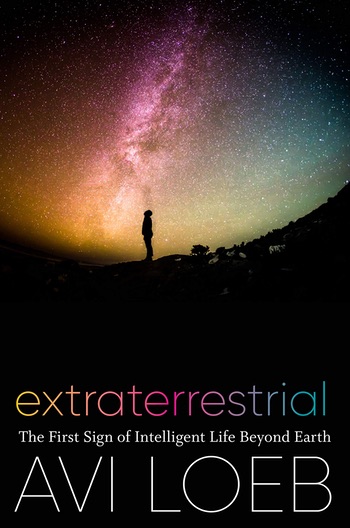Review: Extraterrestrialby Jeff Foust
|
| “It is very presumptuous for us to assume that we are the only intelligence in this vast cosmos,” Loeb writes. |
Signals like this have gotten SETI enthusiasts’ hopes up for decades, such as the “Wow!” signal from the 1970s, but without clear proof that any of those signals come from an extraterrestrial intelligence. But what if there is other evidence—physical rather than electromagnetic—of alien intelligence? That’s the provocative, although not necessarily convincing, argument made by Avi Loeb in his new book, Extraterrestrial.
Loeb is not a crackpot on the fringes of the scientific community: he is chair of the astronomy department at Harvard University and one of the leaders of Breakthrough Starshot, a project to study the development of laser-propelled “lightsails” that could travel to other stars. He is also convinced that there is not just life beyond Earth, but intelligent life. “It is very presumptuous for us to assume that we are the only intelligence in this vast cosmos,” he writes.
He believes there is evidence of such other intelligent life: the object ’Oumuamua, discovered in 2017 as it passed through the inner solar system. The object is the first known object to originate from outside our solar system, flying on a hyperbolic trajectory that will take it out of the solar system. Most scientists think that ’Oumuamua is a natural object, a mix of rock and ice ejected from another solar system.
Loeb disagrees. Much of the book is an argument that ’Oumuamua is a spacecraft, one with a larger version of the lightsail his Breakthrough Starshot group has been studying. The unusual dimensions of the object—“flat, like a pancake,” he says—suggest it is not natural. In addition, there was a very small acceleration by the object as it moved away from the Sun, but without a clear detection of gas or dust emissions that might have caused it. Instead, he argues, that acceleration comes from the lightsail, acting like a solar sail.
The hypothesis is an intriguing one, but it’s just that: a potential explanation that Loeb acknowledges can’t be tested further. “The data we have is all we will ever have, leaving us the task of hypothesizing explanations that fully account for the evidence,” he writes, since ’Oumuamua is no longer observable by the most powerful telescopes and out of range of any spacecraft mission.
| “I believe that my life’s unusual path prepared me for my encounter with ’Oumuamua.” |
Loeb, though, is confident that his hypothesis that ’Oumuamua is an artificial, alien object, and criticizes the scientific establishment for being unwilling to accept it, or anything else about the prospects of extraterrestrial life. “The scientific community’s prejudice or closed-mindedness — however you want to describe it — is particularly pervasive and powerful when it comes to the search for alien life, especially intelligent life.” But astrobiology, that search for alien life in general, is very much in the scientific mainstream now, driving projects ranging from space telescopes to missions to Mars and Europa. Even SETI, which was in the scientific wilderness for years after Congress shut down a NASA program in the early 1990s, has been rehabilitated in recent years, including a willingness by the agency to support research related to “technosignatures” like radio signals.
The book is not entirely about Loeb’s claims about ’Oumuamua. He does offer a bit of a biography, explaining how he was more interested in philosophy growing up on a farm in Israel, but later concluded science was a better way to answer those big philosophical questions. That was first in plasma physics and, later, astrophysics. “I believe that my life’s unusual path prepared me for my encounter with ’Oumuamua,” he writes.
Confident in his hypothesis that the object is artificial, he spends much of the latter part of the book extrapolating implications of that, such as whether the object was directed at our solar system or is the equivalent of space junk from an extraterrestrial civilization. “We are greatly in need of a new branch of astronomy, what I have termed space archaeology,” he argues, to help look the detritus of those civilizations. (He doesn’t note that “space archaeology” is a term currently used for the study of past human space activities, from satellites to old launch sites.)
Loeb makes an intriguing argument about ’Oumuamua in Extraterrestrial, but fails to close the case that the object must be artificial. Just because something can’t be immediately explained by natural phenomena doesn't mean it’s not natural. A rapidly and regularly pulsing radio signal discovered in 1967 was originally nicknamed LGM-1, for “little green men,” since astronomers couldn’t rule out an artificial origin. It turned out to be the first of many pulsars. Perhaps ’Oumuamua will turn out to be the first of many in a new class of interstellar objects with an unusual, but natural, origin. Or, maybe, it will be like the “Wow!” signal, which was never seen again and its source never identified; mysterious, but not necessarily alien.
Note: we are temporarily moderating all comments submitted to deal with a surge in spam.
